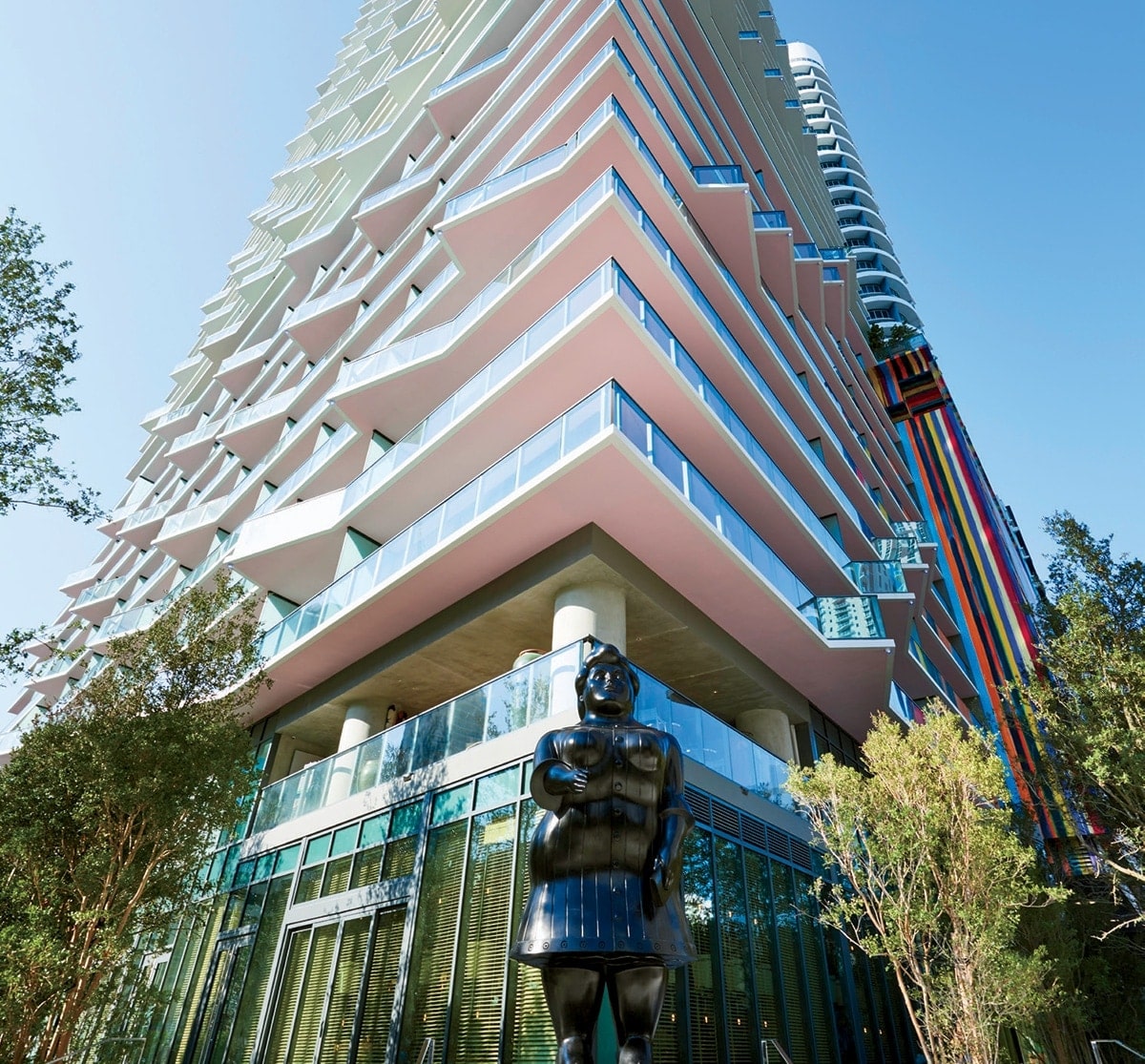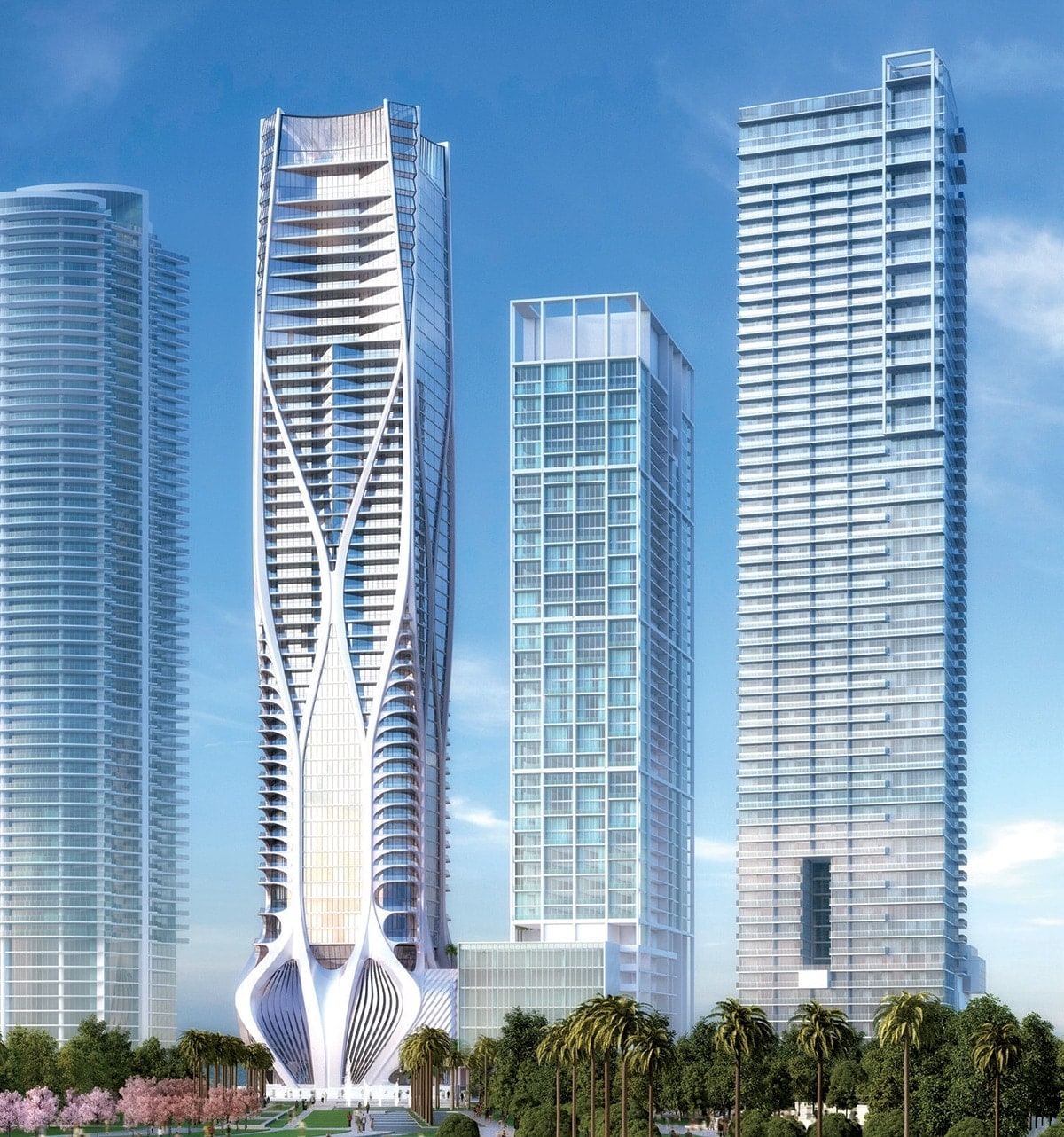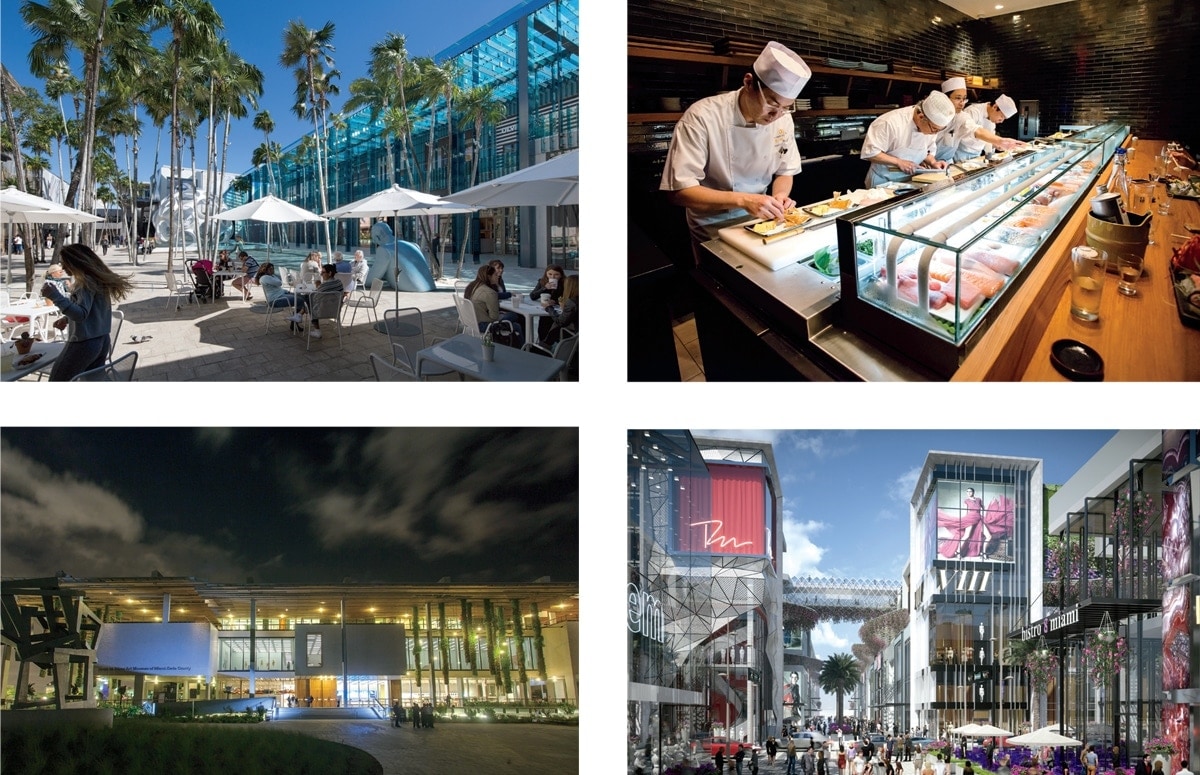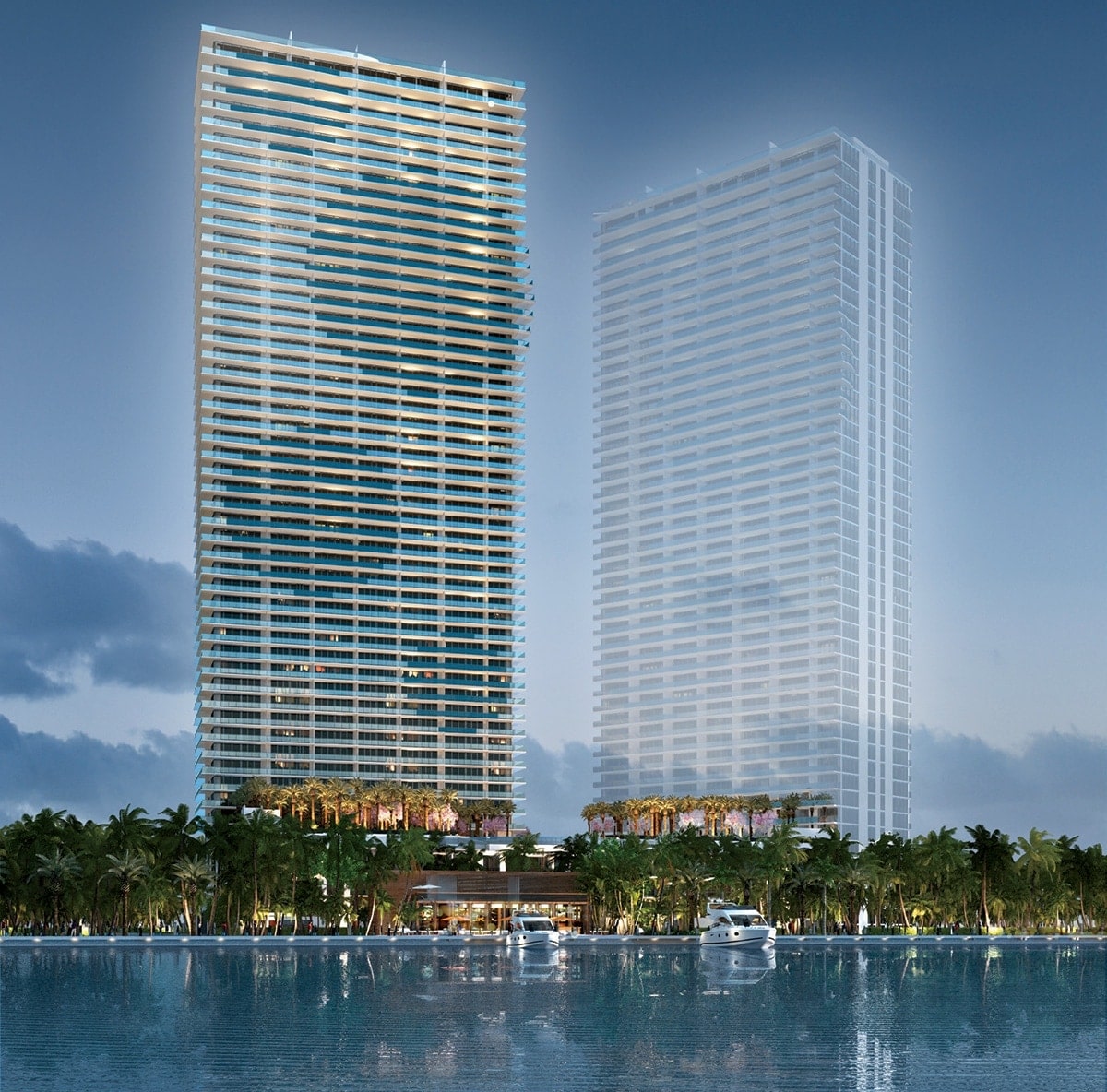How Miami Is Drawing Global Recognition—and Why Everyone Wants a Piece of the Action
March 31, 2017 | Home & Real Estate Feature
No longer just the gateway to the Americas, Miami is now a true global hot spot, attracting attention from Asia, the Middle East, and beyond.
The monumental bronze sculpture by Fernando Botero outside SLS Brickell.
For years, Miami was a place to watch the sun rise, Jet Ski across the bay, and spend untold hours soaking in the scenery. Heaven on earth hopped up on Cuban coffee, the city’s location made it the perfect escape not just from frigid weather to the north, but from political turmoil to the south. The whole world, it seemed, wanted to come to Miami. They still do, of course, but increasingly now, they all want a piece of the action.
“It’s a tropical paradise and a truly urban city,” says Craig Robins, CEO and president of Dacra, the real estate development crew behind Miami’s latest boomtown, the Miami Design District. “Miami has become a city of global cultural substance. It’s hard to define tourist and local. We have full-time residents, we have people who spend the winter here, we have people with second, third, fourth, and fifth homes here, and then we have people staying in hotels. It’s that combination of people who are experiencing Miami in different ways that makes up the totality of our city. It makes Miami a much bigger city than its population.”
One Thousand Museum, designed by Zaha Hadid, one of the starchitects who helped put Miami on the global map.
Indeed, the multimillion-dollar penthouses with helipads at One Thousand Museum (1000museum.com), the Formula One simulators at the Estates at Acqualina, the Olympic-size infinity pools and every other amenity under the sun are attracting tenants from across the planet, turning Miami into a genuinely multicultural city.
“The first few buildings that we started selling in 2010 right after the down cycle, 80 to 90 percent of my buyers were from Argentina, Venezuela, and Colombia,” says Sonia Figueroa, senior vice president of development for the Related Group. “Then you saw buyers coming in from Turkey, Brazil, and Europe.” Related’s Gran Paraiso has drawn customers from more than 40 countries—from Italy, France, and Spain to Abu Dhabi and Kuwait, Russia, China, even the Democratic Republic of the Congo. “When we’re doing our outreach, we’re not only going to South America; we’re going all over the world.” In fact, Canada recently overtook Colombia as the country whose citizens search for South Florida real estate most often, according to the Miami Association of Realtors; among foreign buyers of Miami-area property, Canadians rank fourth. But some experts see a surge coming from the East.
“MIAMI IS AN OPEN CITY AND ONE OF THE EASIEST CITIES TO START A BUSINESS IN, AND THE PRICE POINTS FOR REAL ESTATE ARE EXCEPTIONAL.”—JESSE OTTLEY
“This is the dawn of the Asian era,” says Jesse Ottley, president of Cervera’s Development Division and president of the Greater Miami chapter of the Asian Real Estate Association of America. “I think in the next 10 years, we will see a shift in Miami, and a big part of that will be the influence of Asian investors settling down here.” In fact, the association is holding its Global Luxury Summit right here in Miami, April 21–23—expected to be the largest gathering of Asian- American real estate professionals in the city’s history.
Recently classified an “Alpha–”city by the Globalization and World Cities Research Network (based on its booming economy, diverse population, international trade, and vibrant culture), Miami now has the largest concentration of international banks in the United States.
“We have buyers from Norway, we have buyers from Azerbaijan, we have buyers from Hong Kong—all over the world,” says Harvey Daniels, director of sales at One Thousand Museum, the 62-story downtown tower with just 83 residential units.
The question is why. Miami has had sun and sand forever, so why in the past five or six years has it become more popular than ever before?
“Miami is the Riviera of the South and has always had that energy to it, but in terms of real estate, there is an emergence of ‘starchitects’ coming in and building beautiful monuments that you haven’t seen before,” explains Daniels, who is also vice president of development sales at Sotheby’s International Realty, which represents One Thousand Museum, designed by Pritzker Prize-winning architect Zaha Hadid.
Other examples include SLS Brickell, with interiors by Philippe Starck, and Gran Paraiso, designed by Piero Lissoni. “When Italian purchasers see the name Lissoni, they recognize that brand of elegant Italian design,” says Figueroa of the Related Group. “I think that’s a plus.”
CLOCKWISE FROM TOP LEFT: The Miami Design District; Blue Ribbon Sushi; Paramount Miami Worldcenter; Pérez Art Museum Miami.
Of course, luring a world-renowned architect takes more than a fat paycheck. First Miami needed to build its global brand—a feat it accomplished by attracting a wide range of major events. In the last few months alone, the city has hosted the Miami International Boat Show, the South Beach Wine & Food Festival, the Ultra Music Festival, the Miami Open, and many more. And don’t forget winning three NBA championships in just 10 years, hosting the 2020 Super Bowl, and welcoming the next edition of the legendary soccer match known as El Clásico. Miami is constantly buzzing, catching the eye of jet-setters from around the world. But the real game-changer, according to most observers, was Art Basel, which debuted its Miami Beach edition in 2002, adding the city to the radar of wealthy international collectors, whose private jets filled runways from here to West Palm Beach.
“Art Basel exposed us on a different level,” says Peggy Fucci, president and CEO of OneWorld Properties, the exclusive sales and marketing firm for Paramount Miami Worldcenter. “Miami was not the Miami Vice drug scene that people around the world thought it was. Art Basel brought sophistication, and every year it has grown to exceed the expectations of visitors with restaurants and cultural centers.”
But the city’s cultural development since Art Basel hasn’t just attracted scores of tourists; it has also given them a reason to stay. Institutions like Pérez Art Museum Miami (1103 Biscayne Blvd., 305-375-3000), the Institute of Contemporary Art, Miami, and the Frost Museum of Science, and restaurants such as Joe’s Stone Crab (11 Washington Ave., Miami Beach, 305-673-0365) and Prime 112 (112 Ocean Dr., Miami Beach, 305-532-8112)—two of the top 10 highest-grossing restaurants in the country—made Miami unique. Then, New York City hot spots like Upland (49 Collins Ave., Miami Beach, 305-602-9998), Employees Only (1030 Washington Ave., Miami Beach, 786-264-3945), and Blue Ribbon Sushi Bar & Grill (336 21st St., Miami Beach, 305-800-0404) came south, adding a dash of culinary familiarity for international scenesters.
“Our culinary roots are international and ignore boundaries, and Miami is certainly that kind of place,” says Blue Ribbon owner Ken Bromberg. “One review from the early days referred to our menu as a ‘League of Nations,’ with salt-and-pepper shrimp, escargot, and matzo ball soup all happily coexisting. Miami strikes us as the same kind of city, one where multiple cultures mix and where the clientele appreciates an elevated but casual experience.”
That diversity—in the eats and on the streets—in turn helped attract even more people. “Because Miami is so multicultural, it’s very easy to integrate here,” says Ottley of the Asian Real Estate Association of America. “It’s very easy to come here and be accepted. Twenty years ago, I think a Chinatown would have been an important component, but this new, younger demographic is a lot more integrated and not relying as much on that. Miami is an open city and one of the easiest cities to start a business in, and the price points for real estate are exceptional.”
For the Chinese in particular, Ottley explains, a growing Asian student population at the University of Miami and other local colleges has helped lay the foundation: They arrive, their parents invest in property here, and families begin to put down roots. Add the Hong Kong-based Swire Properties’ development of Brickell Key and Brickell City Centre (and the possibility that the airline Cathay Pacific will soon debut a nonstop flight between Miami and Hong Kong) and the future continues to look bright. “It all begins to weave an interesting story of how South Florida will develop with the Asian market,” he says.
Gran Paraiso.
“China is a market I’ve been cultivating for several years,” adds OneWorld Properties’ Fucci. “Last year I was there five times. For us, the Chinese are our third most important buyer behind Brazil and Turkey.”
No matter where he or she arrives from, the new Miamian has high expectations when it comes to real estate amenities, restaurants, culture, and, of course, shopping. Robins, who created the Design District, knew that for it to be successful, it couldn’t be simply a place to shop.
“We’ve really worked on trying to make the Design District a place where, if you’re visiting Miami, it’s something that you have to see and experience,” he says, citing cultural offerings like the ICA, the de la Cruz Collection (23 NE 41st St., 305-576-6112), Swampspace (3940 N. Miami Ave., 305-710-8631), Locust Projects (3852 N. Miami Ave., 305-576-8570), and his own art collection as some of the area’s attractions. “We have a strong public park, a design and architecture program enabling people to walk around the neighborhood and see extraordinary installations. In addition, you can go and see these amazing global flagship stores that don’t exist in many places in the world. The Hermès store (163 NE 39th St., 305-868-0118) in the Design District is one of six in the world of a certain special category for Hermès.”
But above all, Miami is growing as a global destination because we offer life in unprecedented variety. On the beaches, you can hear dozens of languages being spoken and a never-ending assortment of topics being discussed. The wealthy can get here fast, get around easily, and feel safe. They can do business by the pool or party till the sun comes up. They can revel in the thrill of a city that seems to move at the speed of light, or lounge on a yacht and sip Champagne in slow motion. Best of all, they can brag to their friends that they live in Miami.
“These high-net-worth, globe-trotting individuals who have the funds are trophy property collectors,” says Daniels. “They collect property like they collect art. Miami is a very fun, sexy city, and they like to come here. They’re not the type of investor who’s going to keep it for a year and flip it. That’s not what happens anymore.”




No comments:
Post a Comment
Per favore lasciate il vostro commento o domanda qui: